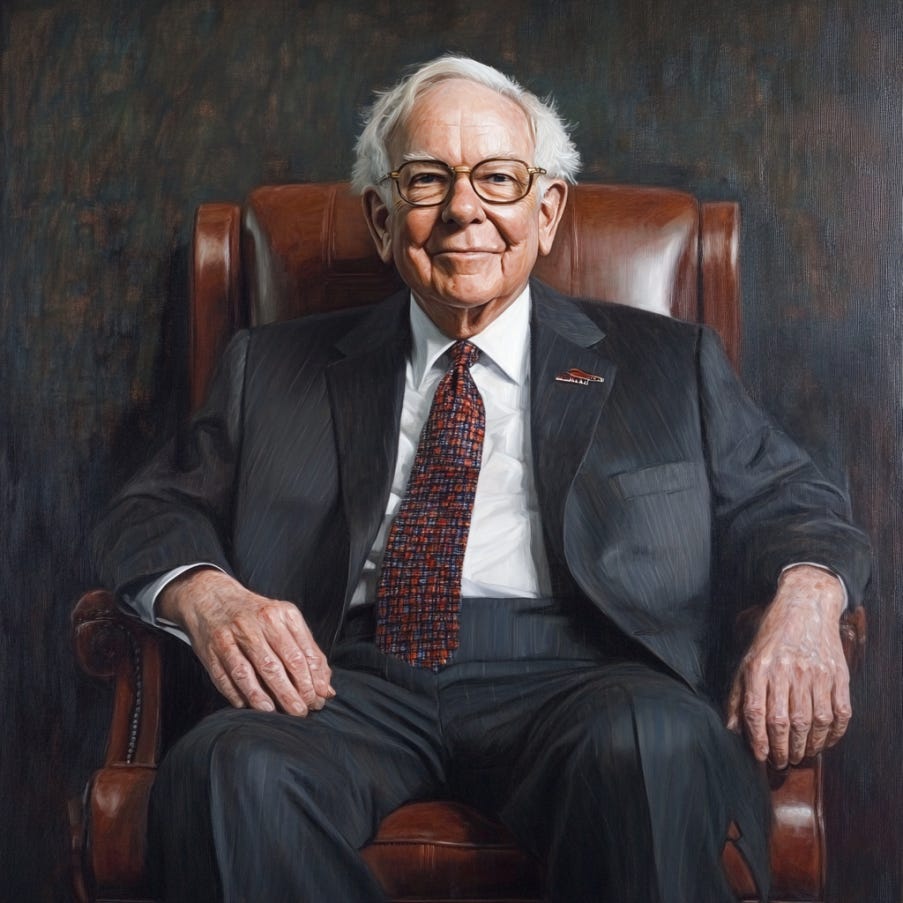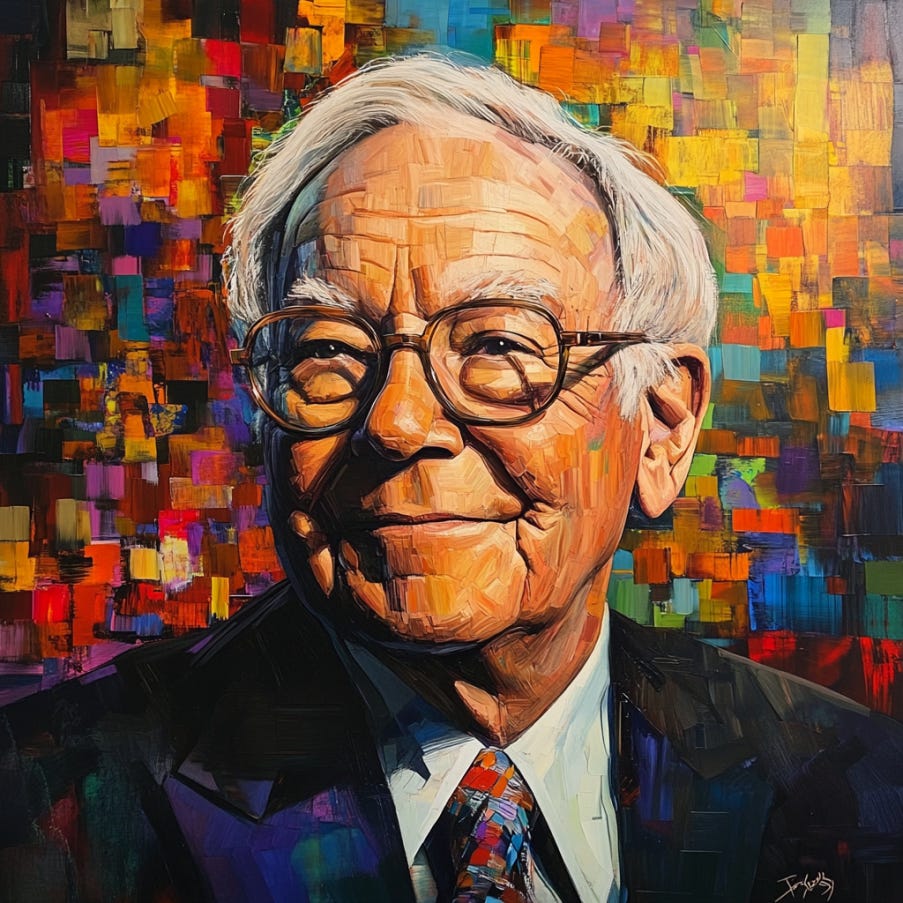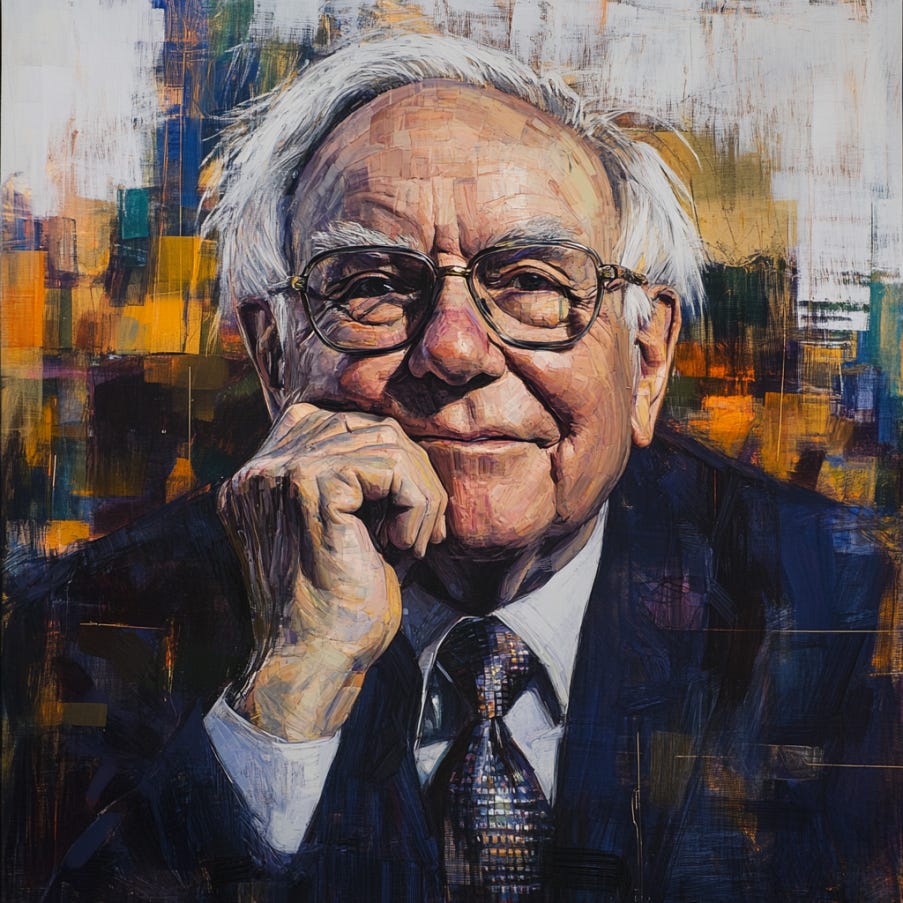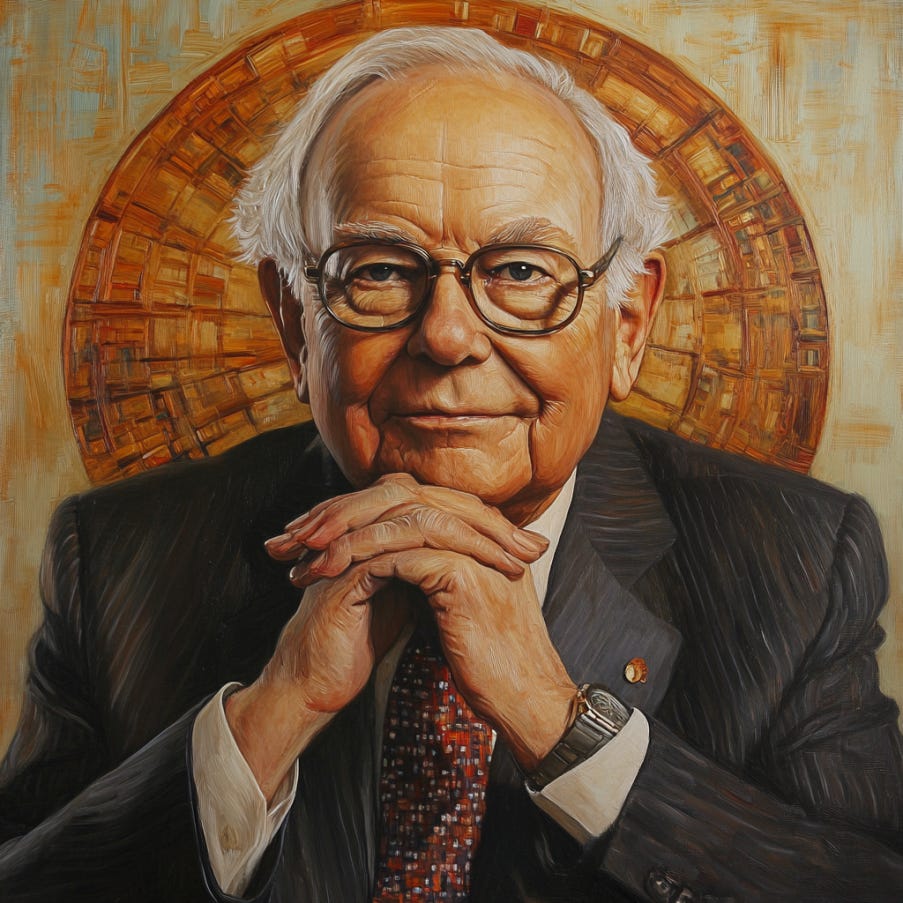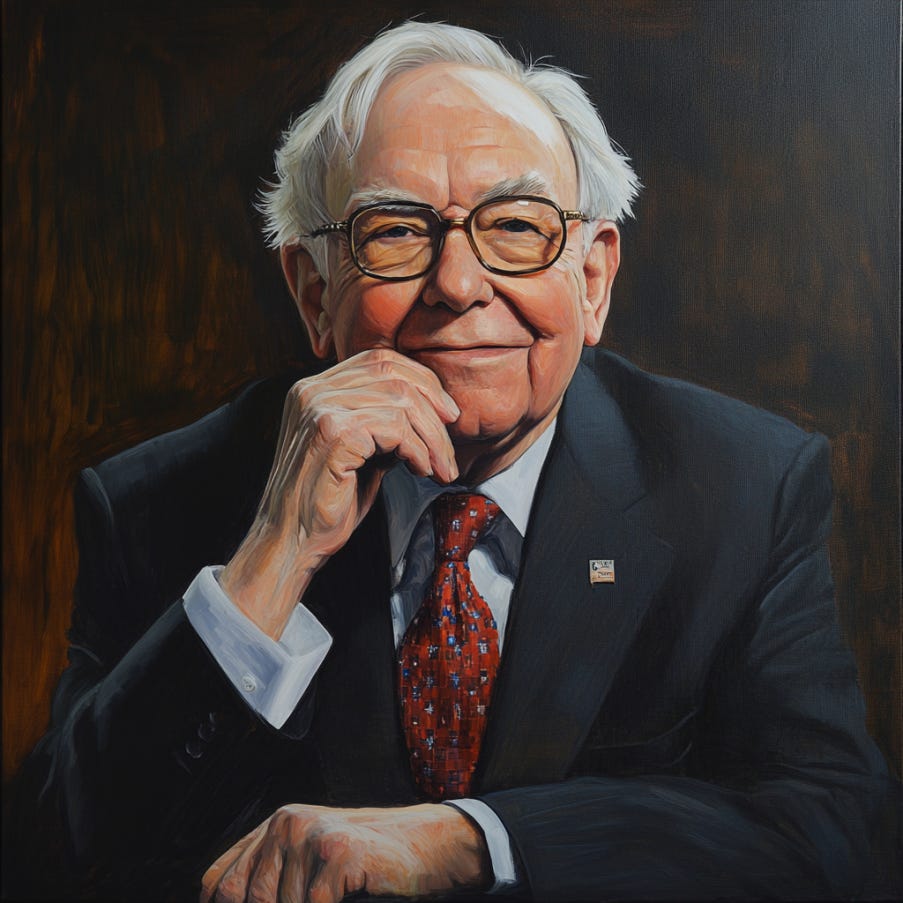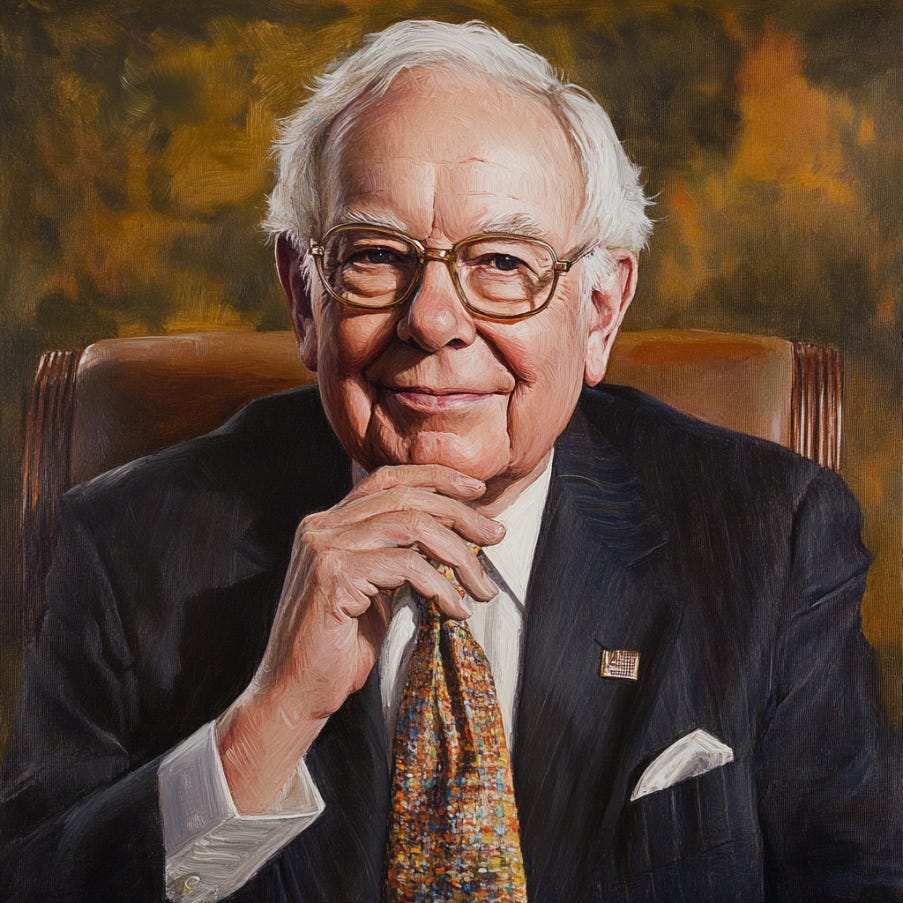Buffett’s Final CEO Meeting (2025): $348B Cash & Abel Succession
The Oracle of Omaha and one of the GOATs hangs it up at age 94...
Below is a ~6 hour video from CNBC with everything Buffet said, as well as commentary/reactions.
Since Warren Buffett took control of Berkshire Hathaway in 1965 until the end of 2024, the company's shares have generated a total return of 5,502,284%; this translates to a compounded annual return of 19.9%.
In comparison, the S&P 500, including dividends, rose by 39,054% over the same period, achieving an average annual gain of 10.4%.
This means Berkshire Hathaway has outperformed the S&P 500 by more than 140x since 1964.
Berkshire Hathaway has realized a Sharpe ratio of 0.76, which is higher than any other stock or mutual fund with a history of more than 30 years.
Research indicates that this performance is not primarily due to luck, but rather a result of using leverage (estimated at an average of 1.6-to-1) combined with a focus on cheap, safe, high-quality stocks.
When these factors are controlled for, Buffett's "alpha," or outperformance beyond known risk factors, becomes statistically insignificant.
This piece covers all the major takeaways from Buffet’s 2025 annual shareholder meeting in Omaha (Buffet’s final meeting as CEO of Berkshire Hathaway).
Regarding the recent stock market correction/fluctuations, Buffet stated the following:
“What happened in the last 30, 45, 100 days, it’s really nothing.”
“This is not a huge move. This has not been a dramatic bear market or anything of the sort.”
Buffet also noted that he would not sell any Berkshire shares despite passing the torch to his successor, Greg Abel:
“The decision to keep every share is an economic decision because I think the prospects of Berkshire will be better under Greg’s management than mine.”
30-Second Snapshot: What Mattered Most in Omaha 2025
Succession finally put on the clock. Warren Buffett, now 94, told the arena he will relinquish the CEO title on 31 December 2025 and asked directors to elect Vice-Chair Greg Abel at that meeting. Buffett will stay on as non-executive chair “to be useful in a few cases,” but capital-allocation authority will pass to Abel the moment the calendar turns. (Reuters)
A war-chest the size of a small nation—ready for a fat pitch. First-quarter filings show Berkshire’s cash and T-bills swelling to a record $347.7 billion, up $13.5 billion since year-end. Asked why he keeps so much idle, Buffett replied: “We came pretty close to spending $10 billion not that long ago—we’d write a $100 billion check tomorrow if the price is right.” (Reuters, Reuters)
Tariffs branded a “big mistake”; Buffett suggests import-certificate fix.
Opening the Q&A, Buffett warned that weaponizing trade “leaves 7.5 billion people angry at 300 million Americans,” calling the new 145% U.S. tariff schedule “a big mistake.” He contrasted it with the market-priced “import-certificate” plan he sketched in 2003—which would cap total imports at the value of exports without singling out countries. (Axios)New $100 million ‘mega-limit’ excess-casualty pool with Chubb & Zurich.
Within 24 hours of the meeting Berkshire’s National Indemnity joined Chubb and Zurich North America to launch a facility that can write up to $100 million of lead excess liability for large corporates—business very few carriers can shoulder. The move underscores Berkshire’s willingness to monetise its fortress balance sheet while sharing tail risk. (Life Insurance International)Float that pays Berkshire 2.2% to hold it. Ajit Jain told shareholders the blended cost of Berkshire’s $170 billion insurance float is –2.2%: “That means somebody hands us the money and pays us 2.2% for the privilege.” The negative cost—rare even in today’s rate environment—remains a durable funding edge for future deals. (Steady Compounding)
Together these data points frame the 2025 meeting: a clear succession date, an unprecedented pile of dry powder, vocal opposition to tariff brinkmanship, a fresh proof-point of Berkshire’s insurance moat, and float economics that still mint free capital.
I.) Leadership & Governance: Succession finally nailed down, board gets a shake-up
1. CEO hand-off: dates, roles, guard-rails
Timeline locked: Buffett told shareholders he will relinquish the CEO title at the end of 2025; Berkshire’s board has already voted to install Vice-Chair Greg Abel as chief executive on 1 January 2026. Buffett will remain on the board as non-executive chair. (Reuters)
Why it matters: Investors no longer need to guess at “someday” — capital-allocation authority will transfer to Abel on a fixed date, letting the market focus on his first big moves rather than on succession uncertainty.
Clear division of labour:
Greg Abel: Continues to run the 189 non-insurance businesses and picks up full capital-allocation power.
Ajit Jain: Retains oversight of the insurance platforms (GEICO, General Re, National Indemnity, etc.). (Reuters)
Howard G. Buffett: Is still pencilled in as the eventual non-executive chair once his father steps aside entirely, preserving the firm’s cultural guard-rails. (Reuters)
2. Board refresh & age-limit surprise
New rule: Directors over 80 (unless they are CEO or hold ≥ 5% voting power) are no longer eligible for re-election. Ron Olson, 83, therefore left the slate this year.
Remaining slate (all ≤ 75): Howard Buffett, Susan Buffett, Steve Burke, Ken Chenault, Chris Davis, Sue Decker (lead director), Charlotte Guyman, Tom Murphy Jr., Wally Scott and Meryl Witmer — plus Buffett, Abel and Jain.
Signal: The rule tightens refreshment without forcing out Buffett himself (he’s exempt as 30% voting-power holder) and keeps the average age below 70 after 2025.
3. Incentives & accountability
Pay tweaks: The proxy filed in March raised both Abel’s and Jain’s annual compensation by $1 million to $21 million apiece, keeping them roughly in line with S&P-500 medians for similarly complex roles.
Buy-back headwind explained: Buffett reminded shareholders that the 1% federal excise tax on repurchases now makes Berkshire pay more than outside buyers — one reason no buy-backs have occurred since May 2024. (Remarks in Q&A; sets expectations for Abel’s capital return toolbox once in charge.)
4. Governance take-aways
Succession Risk: Hard dates are now in place—Buffett will step down at the end of 2025, and Greg Abel will take over in early 2026, following a formal board vote.
Investor implication: The long-standing “key-man” valuation discount should begin to fade. Analysts can start modeling Berkshire under Abel’s leadership with more confidence.
Board Turnover: An enforced age cap is prompting staggered retirements across the board.
Investor implication: This allows new directors with expertise in technology or energy transition to join without disrupting overall board continuity.
Management Pay: Compensation saw a modest increase but remains well below industry averages.
Investor implication: Reinforces Berkshire’s culture of alignment and restraint. The small adjustment is unlikely to raise shareholder concerns or provoke proxy pushback.
Capital Discipline: Berkshire publicly acknowledged the impact of the 1% buyback tax.
Investor implication: Repurchases will be more selective going forward. Investors should expect capital to be deployed primarily through acquisitions unless the stock trades at a deeper discount.
2025 locks in the most significant leadership transition since 1965 and tightens board discipline, all while preserving Berkshire’s decentralized culture. Shareholders now have a calendar for Abel’s ascent and a clearer view of who stewards each pillar of the conglomerate.
II.) Capital & Liquidity Position: Berkshire’s balance-sheet firepower
Record cash stockpile: $347.7 billion. Berkshire finished Q1 2025 with $347.7 billion parked in T-bills and bank deposits, up another $13.5 billion just since year-end — the largest absolute cash balance in corporate history. Buffett acknowledged the drag: “Our financial condition continues to hold a lot more in cash and Treasurys than I would like,” but said the optionality is worth it until “fat pitches” return. (Reuters)
‘Came close’ to a $10 billion deal — patience with a hair-trigger. Pressed on why the hoard keeps growing, Buffett said Berkshire “came close to spending $10 billion recently,” but good deals “never arrive in an orderly fashion.” The comment underscores that the war-chest is not strategic pessimism; it is dry powder for very occasional, very large moves. (Reuters)
10 straight quarters of net selling. With equity valuations stretched, Berkshire again sold more stock than it bought, the 10th consecutive quarter of net dispositions. Whole-company acquisitions were nil, reinforcing the message that Buffett and Abel will wait rather than dilute future returns. (Reuters)
Buy-backs on ice — the 1% excise-tax hurdle. For the third quarter running Berkshire repurchased no shares. Buffett explained that the federal 1% share-buyback excise tax now forces Berkshire to pay more than outside buyers: “If Berkshire buys Berkshire, we pay 1%. That lifts the bar.” Expect repurchases only if the stock trades at a still-deeper discount to intrinsic value.
Negative-cost float: –2.2%. Ajit Jain revealed that Berkshire’s $170 billion insurance float cost the company –2.2% over the past year — policyholders effectively paid Berkshire to hold their money. That free (indeed paying) leverage remains a durable edge; even modest underwriting profits turn the float into a self-funding acquisition currency.
Liquidity comfort vs. deployment mandate: Berkshire’s $347.7B cash pile, $1.5B in net stock sales, zero buybacks, and a $170B float earning 2.2% reflect a strong liquidity position—but also a clear mandate for Abel to deploy capital selectively amid high valuations and limited return from buybacks.
Takeaways for investors:
Berkshire’s liquidity has reached sovereign-fund scale; even a single mega-acquisition could leave >$200 billion unused.
The negative-cost float provides an embedded yield advantage that widens in a higher-rate world.
Share repurchases are now far less likely unless the A/B shares crater; model capital deployment toward bolt-on deals and opportunistic crisis buying instead.
Greg Abel inherits not just the CEO chair but a balance sheet powerful enough to reset Berkshire’s earnings base with one or two transformational transactions.
Together these datapoints paint a picture of a conglomerate that is over-capitalized by choice, unwilling to compromise on price, and uniquely positioned to pounce when policy shocks (like the tariff volley Buffett decried) or market dislocations finally serve up the next fat pitch.
III.) Operating Segments of Berkshire (2025)
A. Insurance — GEICO’s comeback, a new “mega-limit” franchise, and float that pays Berkshire
Takeaway: Underwriting is solidifying just as pricing stays hard and the new mega-limit pool monetizes balance-sheet strength. Insurance will keep subsidizing Berkshire’s war-chest.
B. BNSF Railway — volumes up, margin inching higher
Q1 2025 revenue: $5.7 bn (+1% YoY); net income $1.2 bn (+6%).
Unit volume: up 4% overall; intermodal +9% on West-Coast import rebound; coal tonnage +2%.
Operating ratio: improved to 67.9% (–160 bp). (Progressive Railroading)
Signal: BNSF is clawing back margin lost to PSR competition and weather; modest growth but still a utility-like cash generator inside Berkshire.
C. Berkshire Hathaway Energy (BHE) — wildfire headwinds & a plea for a new U.S. grid
Wildfire liability: PacifiCorp now faces $48 bn of claims and projects pretax losses of $2.75 bn. Abel said, “We cannot be the insurer of last resort … keeping lights on is no longer the first priority when fire risk spikes.” (Reuters)
Buffett’s blunt verdict: Some states are “rat poison” for investor-owned utilities; BHE’s internal valuation is “considerably” lower than two years ago. (Business Insider)
Grid build-out vision: Buffett called for a 1950s–style federal push to modernize the electric grid: “The nation needs incredible improvement—rethinking, redirection … like the Interstate Highway Act.” (E&E News)
Implication: Until liability rules change, BHE growth is capped; long-term upside hinges on federal/state frameworks that let utilities earn regulated returns on massive transmission spend.
D. Smaller operating clusters (industrial, retail, service)
Greg Abel said that of 49 non-insurance subsidiaries 21 were up, 28 down in Q1 — a “mixed” picture but no systemic stress.
Investor lens
Insurance still Berkshire’s super-power: Negative-cost float and a new $100 m facility deepen the moat.
BNSF steady, not spectacular: Enough cash to self-fund cap-ex, no catalyst until intermodal pricing tightens.
Utilities need policy help: Wildfire risk and tariff spats could keep BHE’s multiple depressed; watch legislation in OR, ID, WA.
Capital waiting for dislocation: All three engines throw off cash that rolls into the $347 bn pile, giving Abel room for a transformative move once valuations crack.
IV.) BRK Investment Portfolio Highlights (2025)
1. Apple is still king—even after two rounds of trimming
Holding size: Berkshire ended Q1 with ≈ 905 million Apple shares, worth ≈ $174 billion. (The Times of India)
Why Buffett keeps it: On stage he quipped that “Tim Cook has made Berkshire more money than I ever have,” prompting Cook (in the audience) to stand and wave. (TheTimes.co.uk)
Context: After selling roughly 620 million shares across 2024, Apple still accounts for ~20% of Berkshire’s marketable-equity portfolio and remains the only holding Buffett calls a better business than anything else we own.
2. Japanese trading houses graduate from ‘investment’ to ‘strategic partnership’
Companies: Itochu, Marubeni, Mitsubishi, Mitsui, Sumitomo
Berkshire stake (Mar 2025): ~9.8% each (Reuters)
“In the next 50 years we won’t give a thought to selling those.” — Buffett
Rationale: Buffett likens the sōgō-shōsha to “mini-Berkshires” — diversified, cash-generative, and priced at single-digit earnings multiples.
Capital signal: With Tokyo having relaxed the 10% cap, Abel said Berkshire could nudge stakes above 10% “once currency windows open.”
3. Tenth straight quarter as a net seller of U.S. equities
Q1 flow: Bought $3.2 bn, sold $4.7 bn → net sale $1.5 bn.
Streak: Marks 10 consecutive quarters of net selling, a run that has added $142 bn to the cash pile since 2022. (Business Insider)
Message: Valuations are still “not fat-pitch territory.” Buffett’s bar to deploy the $347 bn war-chest remains high.
4. Small but telling adds & trims
New: Domino’s Pizza
Position: 1.3 million shares (~$0.6 billion)
Read-through: Berkshire is testing Domino’s as a model for asset-light, pricing-power consumer brands. It reflects a broader tilt toward durable franchises with inflation-passing ability and minimal capital needs.
Trim: Bank of America
Position: Reduced stake by 23%
Read-through: Likely a concentration risk move — Bank of America was one of Berkshire’s largest holdings. The trim freed up an estimated $10 billion in cash, possibly ahead of larger capital allocation decisions.
5. Portfolio concentration snapshot (post-Q1 2025)
Top 5 positions (Apple, AmEx, BofA, Coca-Cola, Chevron) = ≈ 71% of reported equities.
Sector tilt: Tech 27%, Financials 35%, Consumer Defensive 16%. (Morningstar)
Investor takeaways:
Apple and Japan are long-duration core bets, not trading positions; expect minimal further trimming unless valuations spike.
Ongoing U.S. equity selling says Buffett/Abel still see better risk-adjusted returns in short-term T-bills than in a fully-priced stock market.
Selective nibbling (e.g., Domino’s) shows the bar for new ideas is low dollars, high conviction; anything >$5 bn will likely have a “Berkshire-like” moat.
Cash + negative-cost float give Abel optionality to swing hard when the next fat pitch—likely a distressed mega-deal—finally crosses the plate.
V.) Macro & Policy Commentary: Buffett’s big-picture alarms & prescriptions
A. Tariffs: “An act of economic war”
The critique. Buffett opened the floor session warning that punitive duties turn trade into “an act of war,” adding: “When 7.5 billion people are mad at 300 million Americans, that’s a big mistake.” (Investopedia)
Why he hates the new 145% U.S. schedule. Taxes are paid by U.S. importers first, inflating consumer prices; it invites tit-for-tat retaliation against BNSF grain, Precision Castparts aero-parts and other Berkshire exports; and it injects policy risk that can freeze capital investment.
B. Balanced-trade goal, import-certificate (IC) solution
Concept. Reviving his 2003 Fortune essay, Buffett said a market-traded IC system would cap aggregate imports at the value of exports. Exporters earn certificates; importers must buy and surrender them at the dock. (Fortune)
How ICs differ from tariffs. Country-agnostic, rules-based and self-adjusting: the IC price does the rationing, so governments stop picking bilateral winners. Buffett argued that makes retaliation less likely and gives CEOs a predictable cost curve.
Real-world hurdles. Trade economists note potential WTO challenges and near-term inflation if IC prices spike, but most concede it would close the chronic U.S. deficit mathematically. Buffett called it “gimmicky, but better than a shooting match.”
C. Currency warning & the U.S. fiscal time-bomb
“We wouldn’t own a currency that’s going to hell.” Asked how Berkshire decides when to hedge, Buffett replied he won’t hold assets denominated in money a government is debasing. Then came the twist: unchecked U.S. deficits could put the dollar on that path.
Deficits are his single macro fear. Later he lumped trillion-dollar federal shortfalls with weaponized trade as the two policy moves that could damage long-run U.S. prosperity. (Reuters)
D. Energy infrastructure: a federal-scale grid reboot
“Incredible improvement” needed. Buffett compared today’s fragmented electric grid to pre-Eisenhower highways: only Washington’s muscle can knit 50 jurisdictions into a modern, high-voltage backbone. Berkshire Hathaway Energy has capital and know-how ready, “but we need a framework that works for taxpayers and investors.”
Investor angle. A federally backed transmission build-out could unlock hundreds of billions in rate-base projects—catnip for BHE if wildfire-liability rules are also fixed.
Policy take-aways for shareholders
Tariff volatility = margin risk. Multinationals that import components or sell abroad face higher cost swing and retaliation danger.
Dollar drift scenario. Even a 5% probability that deficits cheapen the greenback justifies some non-USD or inflation-linked exposure.
Grid megacapex play. If a national-grid act emerges, regulated utilities with balance-sheet heft—BHE first among them—stand to earn quasi-guaranteed returns for decades.
Buffett’s macro message links every thread: curb chronic trade and fiscal imbalances before they debase the currency, ditch bilateral tariff skirmishes for a universal market mechanism, and harness public-private muscle to rebuild critical infrastructure that can soak up Berkshire’s record cash pile at attractive, regulated returns.
VII.) Final Investor Takeaways: Buffet & Berkshire Hathaway (May 2025)
1. Succession Discount Should Fade
A firm date: Buffett steps down Dec 31, 2025, and Greg Abel takes over Jan 1, 2026. This removes the persistent “what if Buffett?” overhang that has long weighed on Berkshire’s valuation. (Business Insider, Reuters)
Practical move: Re-run intrinsic-value models without a key-man haircut. Berkshire shares tend to re-rate positively when succession uncertainty clears.
2. $348 Billion Cash = Crisis Optionality
Berkshire’s cash pile—roughly 28% of market cap—is parked in T-bills earning over 5%, but can be deployed instantly in a distressed mega-deal. (Fortune, Business Insider)
Practical move: Keep a watchlist of Berkshire-style targets—capital-light, cash-generative, with enduring moats. Abel will be under pressure to deploy within 24 months.
3. Insurance Moat Getting Deeper
(a) A new $100 million excess-casualty pool with Chubb and Zurich opens a lucrative niche for Berkshire; (b) the group’s insurance float still pays 2.2%—free leverage few can replicate. (ReinsuranceNe.ws, Steady Compounding)
Practical move: Re-weight toward insurers or brokers that can partner with this facility or benefit from hard-market pricing. Model strong underwriting EBIT through 2026.
4. Utility Drag Until Wildfire Laws Change
PacifiCorp faces $48 billion in wildfire claims. Abel warned that some states are “rat poison” for investor-owned utilities, due to unlimited liability exposure. (Reuters)
Practical move: Treat Berkshire Hathaway Energy like a regulated bond proxy: stable cash, limited growth. Monitor legislation in Oregon, Washington, and Idaho for liability caps.
5. Tariff Brinkmanship = Headline-Risk Trade
Buffett called the proposed 145% tariff plan a “big mistake” and advocated for a rules-based fix like import certificates. (Salon)
Practical move: Stress-test margin assumptions for companies with import-heavy inputs or China exposure. Favor firms with pricing flexibility like software or staples.
6. Buy-Back Throttle Is Real
The new 1% U.S. excise tax on buybacks has made Berkshire more price-sensitive. The company has executed no repurchases YTD. (Barrons)
Practical move: Don’t count on buybacks to support EPS. Future repurchases are unlikely unless shares trade well below book value.
7. Dollar-Debasement Hedge
Buffett warned that the USD could “go to hell” if deficits continue unchecked, and signaled support for rebalancing U.S. trade. (Reuters)
Practical move: Keep a sleeve of TIPS, high-quality foreign equities, or real assets as a long-term hedge against dollar decline or structural inflation.
Berkshire exits the 2025 AGM with (1) a timestamped hand-off to Abel, (2) sovereign-scale cash earning 5% while it waits for chaos, (3) an insurance engine that now monetizes its balance-sheet edge in a hard market, and (4) a utility arm that needs legislative relief before it can grow again. Position portfolios for patience-plus-optionality — the same posture Buffett himself just showcased on stage.


